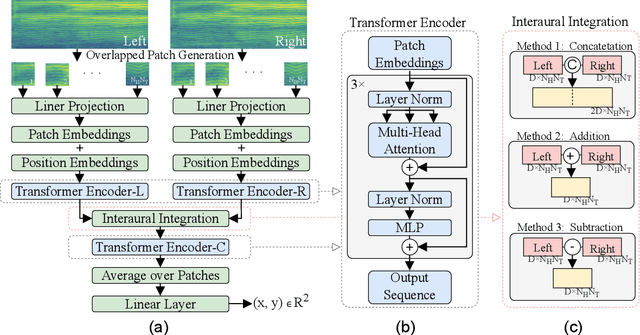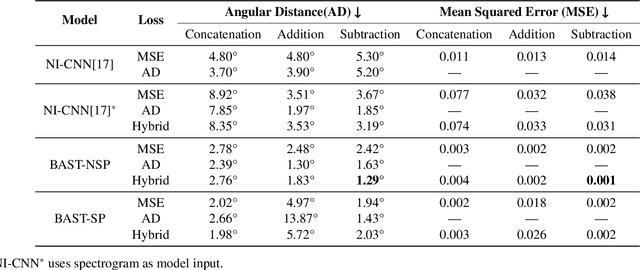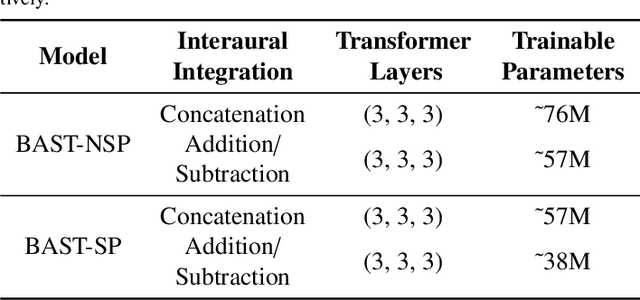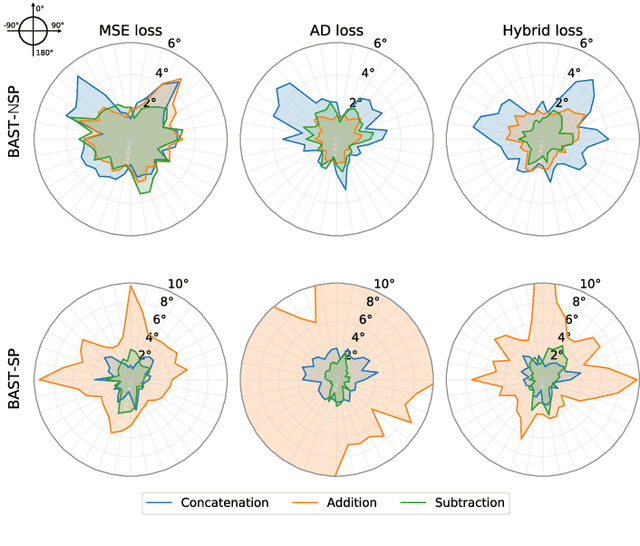Kiki van der Heijden
Leveraging Spatial Cues from Cochlear Implant Microphones to Efficiently Enhance Speech Separation in Real-World Listening Scenes
Jan 24, 2025Abstract:Speech separation approaches for single-channel, dry speech mixtures have significantly improved. However, real-world spatial and reverberant acoustic environments remain challenging, limiting the effectiveness of these approaches for assistive hearing devices like cochlear implants (CIs). To address this, we quantify the impact of real-world acoustic scenes on speech separation and explore how spatial cues can enhance separation quality efficiently. We analyze performance based on implicit spatial cues (inherent in the acoustic input and learned by the model) and explicit spatial cues (manually calculated spatial features added as auxiliary inputs). Our findings show that spatial cues (both implicit and explicit) improve separation for mixtures with spatially separated and nearby talkers. Furthermore, spatial cues enhance separation when spectral cues are ambiguous, such as when voices are similar. Explicit spatial cues are particularly beneficial when implicit spatial cues are weak. For instance, single CI microphone recordings provide weaker implicit spatial cues than bilateral CIs, but even single CIs benefit from explicit cues. These results emphasize the importance of training models on real-world data to improve generalizability in everyday listening scenarios. Additionally, our statistical analyses offer insights into how data properties influence model performance, supporting the development of efficient speech separation approaches for CIs and other assistive devices in real-world settings.
Audio-Driven Reinforcement Learning for Head-Orientation in Naturalistic Environments
Sep 16, 2024Abstract:Although deep reinforcement learning (DRL) approaches in audio signal processing have seen substantial progress in recent years, audio-driven DRL for tasks such as navigation, gaze control and head-orientation control in the context of human-robot interaction have received little attention. Here, we propose an audio-driven DRL framework in which we utilise deep Q-learning to develop an autonomous agent that orients towards a talker in the acoustic environment based on stereo speech recordings. Our results show that the agent learned to perform the task at a near perfect level when trained on speech segments in anechoic environments (that is, without reverberation). The presence of reverberation in naturalistic acoustic environments affected the agent's performance, although the agent still substantially outperformed a baseline, randomly acting agent. Finally, we quantified the degree of generalization of the proposed DRL approach across naturalistic acoustic environments. Our experiments revealed that policies learned by agents trained on medium or high reverb environments generalized to low reverb environments, but policies learned by agents trained on anechoic or low reverb environments did not generalize to medium or high reverb environments. Taken together, this study demonstrates the potential of audio-driven DRL for tasks such as head-orientation control and highlights the need for training strategies that enable robust generalization across environments for real-world audio-driven DRL applications.
BAST: Binaural Audio Spectrogram Transformer for Binaural Sound Localization
Jul 08, 2022



Abstract:Accurate sound localization in a reverberation environment is essential for human auditory perception. Recently, Convolutional Neural Networks (CNNs) have been utilized to model the binaural human auditory pathway. However, CNN shows barriers in capturing the global acoustic features. To address this issue, we propose a novel end-to-end Binaural Audio Spectrogram Transformer (BAST) model to predict the sound azimuth in both anechoic and reverberation environments. Two modes of implementation, i.e. BAST-SP and BAST-NSP corresponding to BAST model with shared and non-shared parameters respectively, are explored. Our model with subtraction interaural integration and hybrid loss achieves an angular distance of 1.29 degrees and a Mean Square Error of 1e-3 at all azimuths, significantly surpassing CNN based model. The exploratory analysis of the BAST's performance on the left-right hemifields and anechoic and reverberation environments shows its generalization ability as well as the feasibility of binaural Transformers in sound localization. Furthermore, the analysis of the attention maps is provided to give additional insights on the interpretation of the localization process in a natural reverberant environment.
 Add to Chrome
Add to Chrome Add to Firefox
Add to Firefox Add to Edge
Add to Edge